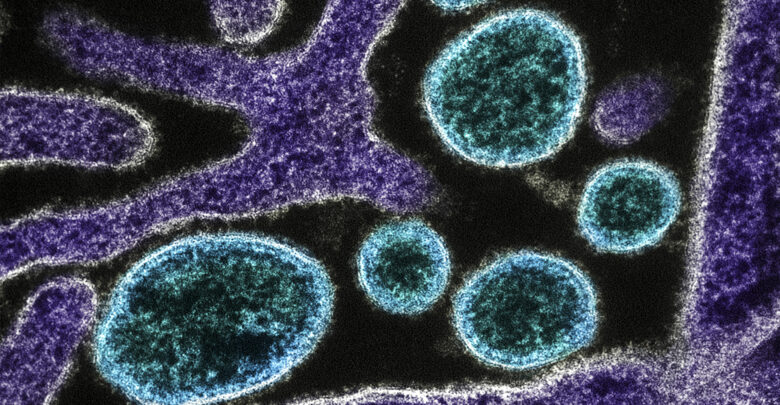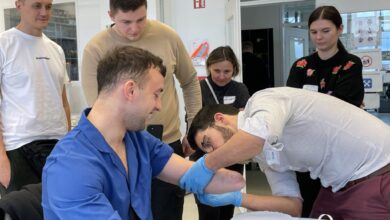

NEW DELHI — Following the death of a 12-year-old in southern Indian state’s— Kerala— Kozhikode, the first Nipah virus fatality in the state, the experts stressed the importance of ascertaining the source of transmission of the fatal virus, which is highly contagious.
It jumps from animals to humans in whom high morbidity and mortality rates have been observed.
The fruit bats are the virus carriers, as per Ashutosh Biswas, Professor, Department of Medicine at All India Institute of Medical Sciences (AIIMS).
“Fruit bats are the carriers of the virus, and they are the main cause of transmission,” he said.
“Fruit bats live in a specific geographical territory. If they fly to other places, naturally, this virus can be transmitted. We don’t have a specific treatment for the disease. So, we have to understand that this is a severe disease and is associated with high morbidity and mortality.”
Biswas said that Nipah is a Zoonotic disease and the animals are its carriers, especially the fruit bats.
“In the past, we have seen and observed in India that the fruit bats can also transmit it to our domestic animals like pigs, goats, cats, horses, and others,” he said. “So, the jumping of this virus from animals to humans is very dangerous and is what we call a spillover.”
“Once this virus gets into human circulation, it starts to transmit from human to human, and the transmission is so fast that it can spill over,” said Biswas highlighting the importance of detecting the source. “Therefore, it is important to identify the source in the beginning. As indicated, we have found that the transmission is from fruits bats.”
Biswas said that eating the fallen half-eaten fruits without washing them is a hazardous habit.
As per the World Health Organization (WHO), the Nipah virus is caused by fruit bats and is potentially fatal to humans and animals. The virus can also cause fever, muscular pain, headache fever, dizziness, nausea, and respiratory illnesses.
“We have had two Nipah virus outbreaks before this one; once in Kerala, once in West Bengal,” Biswas said.
“During the last outbreak, about 90 percent of the infected persons died. Then in 2019, we had just 1 case of the virus, and now in 2021, we have got another case, a fatal one. So, it is important to understand why it is happening.”
He said the problem is global, and several other countries near the Indian Territory, like Bangladesh, have had repeated virus outbreaks.
The Central government had rushed a medical team to the Kozhikode district of Kerala when the state reported the first death due to the Nipah virus. The team also visited the house of the boy who died of the virus and collected samples of Rambutan fruits from the vicinity to identify the source of the infection.
The Union Ministry of Health and Family Welfare has written to Kerala Chief Secretary V.P. Joy recommending measures to control the spread of the Nipah virus in the state and directed him to strengthen the hospital-based community-based surveillance.
“Both the hospital-based and community-based surveillance needs to be strengthened. Awareness needs of Acute Encephalitis Syndrome/Respiratory Distress and risk communicated to the public,” wrote Rajesh Bhushan, Chief Secretary of Health Ministry, based on the report submitted by the National Centre for Disease Control’s Central team which was deputed to Kozhikode.
“It also visited the epi-center, house of the 12-year-old male diseased child, interacted with family members and others.”
He said the central team has carried out field investigations along with District Surveillance Officer and other officials.
Recommending the measures, the union health secretary said that active search for cases to be undertaken in the containment area, as per the micro plan provided by the Central team, adding that that nearby districts like Kannur, Malappuram, and Wayanad need to alert.
“The district authorities must identify primary and secondary contacts and prepare line listing of high-risk and low-risk contacts,” he said. “All high-risk contacts may be moved to identified quarantine and observed for symptoms.”
“Presently, the National Institute of Virology (Alleppy) is providing laboratory support,” said Bhushan. “As per request from the State government, DG-ICMR has initiated action to establish a point of care testing at Virus Research and Diagnostic Laboratory, Kozhikode.”
“Government Medical College, Kozhikode has been identified as the treatment center,” said the IAS officer about the hospital infrastructure and logistics. “An adequate number of single room isolation facility, negative pressure intensive care unit may be earmarked as stand by.”
“A referral system be established along with earmarked ambulances and trained staff. Adequate stock of Ribavirin (anti-viral) and personal protective equipment should be maintained at the district level. Indian Council of Medical Research is exploring the feasibility of getting appropriate monoclonal antibodies for treatment purposes.”
“Coordination with Animal, Health and Wildlife department and other field officers may be initiated to trap and collect samples from fruit bats for virological studies,” he wrote, stating that around-the-clock Control room needs to be set up for daily reporting and sharing information.
Bhushan said that the union health ministry is committed to extending all possible technical support to the state government in effectively addressing the present problem.
(With inputs from ANI)
Edited by Saptak Datta and Ritaban Misra
The post Nipah Is Serious Disease With High Morbidity, Mortality: India’s Top Health Expert appeared first on Zenger News.




